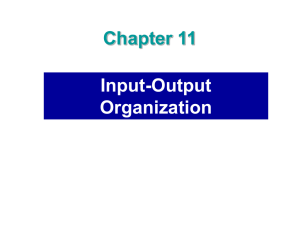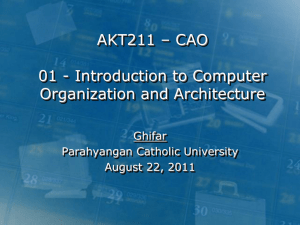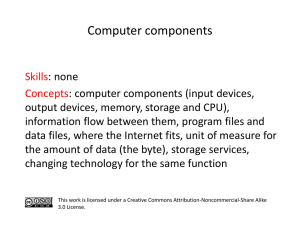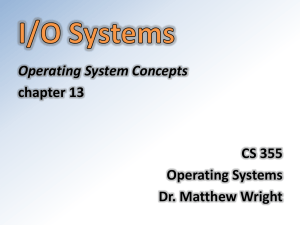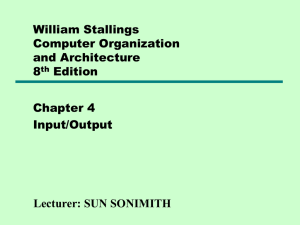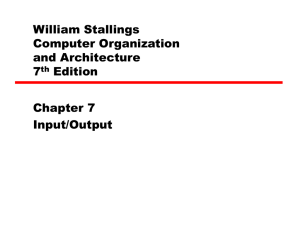I/O Principles
advertisement
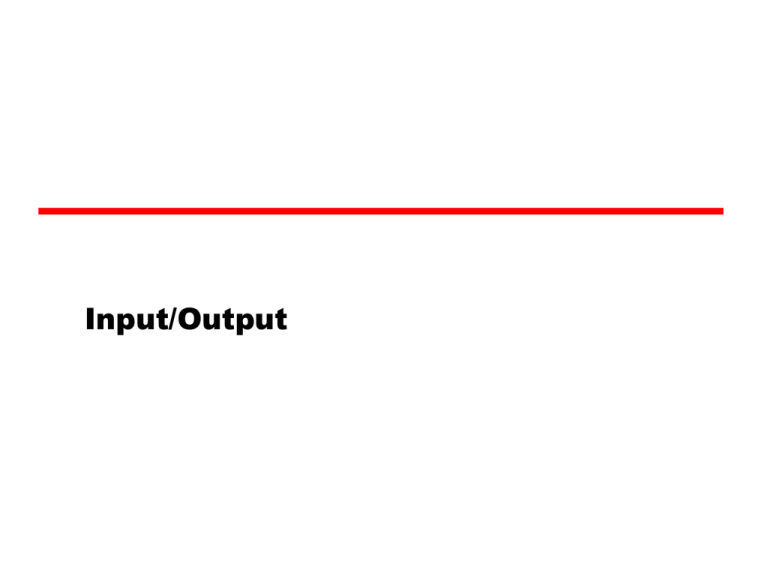
Input/Output Input/Output Problems • Wide variety of peripherals —Delivering different amounts of data —At different speeds —In different formats • All slower than CPU and RAM • Need for I/O modules 1 Input/Output Module • Interface to CPU and Memory • Interface to one or more peripherals • I/O module – I/O adapter (equal concepts) 2 Generic Model of I/O Module 3 External Devices • Human readable —Screen, printer, keyboard • Machine readable —Monitoring and control • Communication —Modem —Network Interface Card (NIC) 4 External Device Block Diagram 5 I/O Module Function • • • • • Control & Timing CPU Communication Device Communication Data Buffering Error Detection 6 I/O Steps • • • • • • CPU checks I/O module device status I/O module returns status If ready, CPU requests data transfer I/O module gets data from device I/O module transfers data to CPU Variations for output, DMA, etc. 7 I/O Module Diagram 8 Input Output Techniques • Programmed • Interrupt driven • Direct Memory Access (DMA) They differ in the way in which I/O module informs CPU that the peripheral operation has finished. 9 Three Techniques for Input of a Block of Data 10 Programmed I/O • CPU has direct control over I/O —Sensing status —Read/write commands —Transferring data • CPU waits for I/O module to complete operation • Wastes CPU time 11 Programmed I/O - detail • • • • • • • CPU requests I/O operation I/O module performs operation I/O module sets status bits CPU checks status bits periodically I/O module does not inform CPU directly I/O module does not interrupt CPU CPU may wait or come back later 12 I/O Commands • CPU issues address —Identifies module (& device if >1 per module) • CPU issues command —Control - telling module what to do – e.g. seek operation on disk —Test - check status – e.g. power? Error? —Read/Write – Module transfers data via buffer from/to device 13 Addressing I/O Devices • Under programmed I/O data transfer is very like memory access (CPU viewpoint) • Each device given unique identifier • CPU commands contain identifier (address) 14 I/O Mapping • Memory mapped I/O — Devices and memory share an address space — I/O looks just like memory read/write — No special commands for I/O – Large selection of memory access commands available • Isolated I/O — Separate address spaces — Need I/O or memory select lines — Special commands for I/O – Limited set 15 Interrupt Driven I/O • Overcomes CPU waiting • No repeated CPU checking of device • I/O module interrupts when ready 16 Interrupt Driven I/O Basic Operation • CPU issues read command • I/O module gets data from peripheral whilst CPU does other work • I/O module interrupts CPU • CPU requests data • I/O module transfers data 17 CPU Viewpoint • Issue read command • Does other work • Check for interrupt at end of each instruction cycle • If interrupted:—Save context (registers) —Process interrupt – Fetch data & store 18 Changes in Memory and Registers for an Interrupt 19 Design Issues • How do you identify the module issuing the interrupt? • How do you deal with multiple interrupts? —i.e. an interrupt handler being interrupted 20 Identifying Interrupting Module (1) • Different line for each module —PC —The number of devices is limited. • Software poll —CPU asks each module in turn —Slow 21 Multiple Interrupts • Each interrupt line has a priority • Higher priority lines can interrupt lower priority lines • If bus mastering only current master can interrupt 22 ISA Bus Interrupt System • ISA bus chains two 8259As together • Link is via interrupt 2 • Gives 15 lines —16 lines less one for link • IRQ 9 is used to re-route anything trying to use IRQ 2 —Backwards compatibility • Incorporated in chip set 23 82C59A Interrupt Controller 24 Direct Memory Access • Interrupt driven and programmed I/O require active CPU intervention —Transfer rate is limited —CPU is tied up • DMA is the answer 25 DMA Function • Additional Module (hardware) on bus • DMA controller takes over from CPU for I/O 26 Typical DMA Module Diagram 27 DMA Operation • CPU tells DMA controller:—Read/Write —Device address —Starting address of memory block for data —Amount of data to be transferred • CPU carries on with other work • DMA controller deals with transfer • DMA controller sends interrupt when finished 28 I/O Channels • • • • • I/O devices getting more sophisticated e.g. 3D graphics cards CPU instructs I/O controller to do transfer I/O controller does entire transfer Improves speed —Takes load off CPU —Dedicated processor is faster 29 I/O Channel Architecture 30

